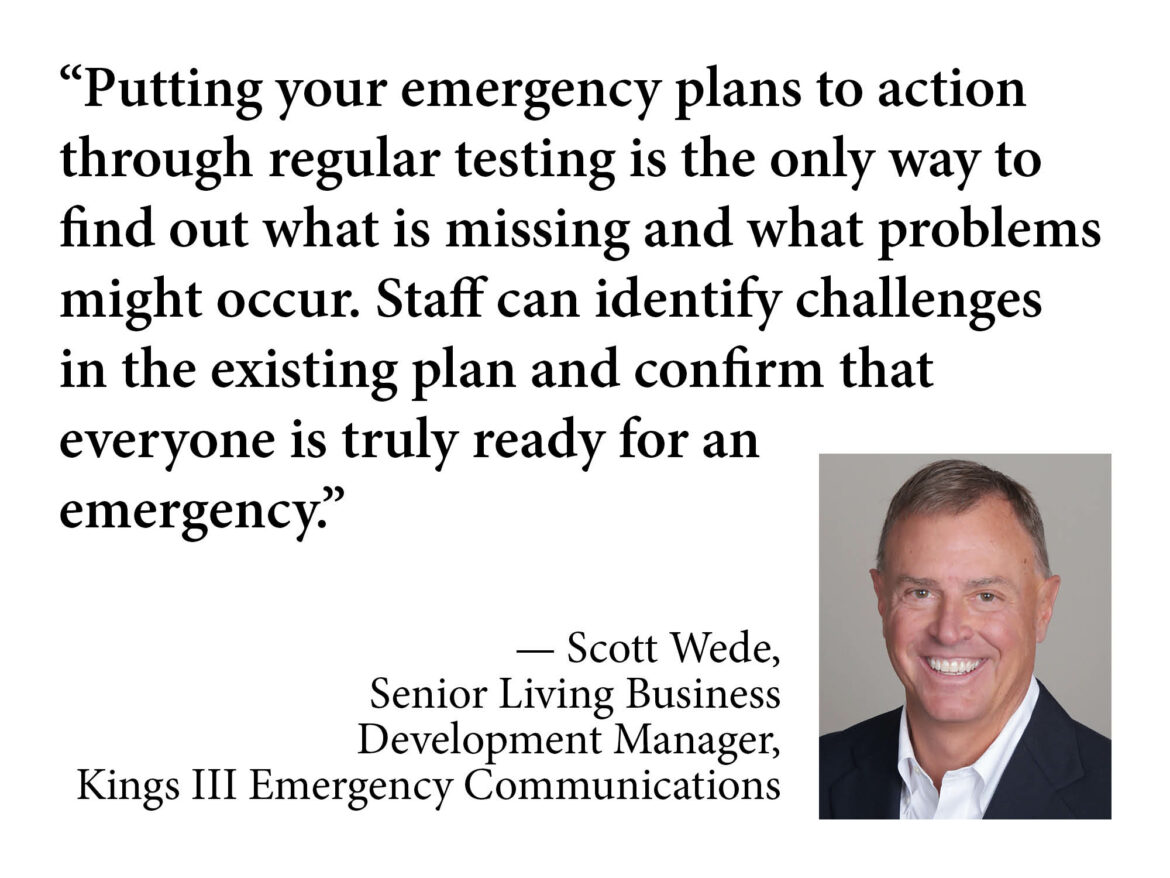In seniors housing, safety isn’t just a protocol; it’s a promise. With residents and their loved ones relying on clear communication and quick responses, creating and maintaining a robust emergency action plan (EAP) tailored for senior living communities is essential.
From fires and severe weather to power outages and elevator malfunctions, preparation and well-tested systems can help to keep seniors safe and cared for, while reassuring families and reducing property risk. Here’s how owners and operators can build a safer, more responsive environment for residents, staff and families alike.
EAP: Laying the Groundwork
An effective EAP acts as a customized roadmap for navigating emergencies. It should include evacuation procedures, communication systems, designated roles and building-specific hazard assessments, including protocols tailored to a wide range of specific scenarios so that each response is adapted to the unique challenges of the situation. This approach allows communities to move beyond generic plans, providing staff with clear, actionable steps for a variety of emergencies.
Examples of the types of emergencies to consider in an EAP include:
- Natural disasters
- Fires
- Medical emergencies
- Criminal threats/criminal activity
However, for seniors housing, this is just the baseline.
“Many operators are required by OSHA to have an EAP,” says Scott Wede, senior living business development manager at Kings III Emergency Communications. “But not all plans reflect the real needs of a senior care facility. Mobility issues, hearing impairments and cognitive conditions can all affect how a resident may respond in an emergency.”
Residents may not be able to evacuate quickly or follow standard instructions, so the EAP must outline adaptive measures.
Who Does What in a Crisis?
Clarity during a crisis starts with well-defined roles. Every senior living community should establish a chain of command with documented responsibilities. Typical roles include the following:
- Building Manager: Maintains and updates the EAP, coordinates drills and confirms that systems function properly.
- Emergency Coordinator: Alerts staff and residents, communicates with emergency services and supervises evacuations or lockdowns.
- Floor Monitors/Area Monitors/Evacuation Wardens: Guide residents to safety, assist those needing help and report missing persons.
Training and regular drills are essential. Drills in particular reveal gaps in training and enable staff to act under pressure or in cases where the first plan of action isn’t feasible.
“Putting your emergency plans to action through regular testing is the only way to find out what is missing and what problems might occur. Staff can identify challenges in the existing plan and confirm that everyone is truly ready for an emergency,” Wede says.
Creating & Updating Your Life Safety Plan: A Checklist
1. Conduct a Property Risk Assessment. Evaluate scenarios including building incidents (fires, elevator malfunctions, medical events, power outages), security concerns, natural disasters.
2. Define Emergency Scenarios. Customize for building layouts and resident needs.
3. Assign Roles and Responsibilities. Include backups and alternates.
4. Implement Communication Infrastructure. Phones, signage, PA systems and VMS-equipped elevators.
5. Train Staff and Conduct Drills. Test both process and response.
6. Review and Revise Quarterly. Update as staff changes, renovations occur or systems are upgraded.
Zooming In: Communication Systems Provide a Safety Net
Of the key EAP components mentioned above, the communication structure is the throughline of every emergency response strategy, and it’s where we’ll place our key focus throughout this article. To connect residents, staff, emergency services and support teams in real time, every senior living community should have the following:
- Building-wide notification systems (alarms, intercoms, visual alerts)
- Monitored emergency phones in code-required areas (e.g., elevators and pools), as well as vulnerable or isolated areas (e.g., stairwells and parking areas)
- Two-way audiovisual systems for those with speech or hearing difficulties
In many senior living communities, emergency phones and elevator call buttons have traditionally been programmed to ring through to a nurses’ area or the front desk. But this approach assumes someone is always available to answer. Routing calls to a trained emergency dispatch center and away from nurses’ stations eliminates bandwidth issues and makes roles clearer.
“If that call goes unanswered, it’s a serious liability,” Wede explains. By routing internal emergency calls directly to a 24/7 emergency dispatch center staffed by trained professionals, properties can drive faster, expert help for residents and significantly reduce their risk. Under this setup, residents aren’t left waiting for help due to staffing limitations. This strategy also removes misplaced responsibilities from onsite personnel who may be responding to urgent tasks (including helping other patients), attending to incoming calls and questions or sheltering in place. On the other hand, a purpose-built emergency response solution allows for a dedicated response, performed by specialized professionals.
Elevators: A Critical Piece of the Safety Puzzle
“Elevators aren’t just transportation,” Wede says. “They’re critical zones even during non-emergencies and should be treated as communication hubs.”
Wede emphasizes how elevators are often overlooked in safety and communication planning. In fact, he notes that many operators don’t even know where their elevator emergency calls are routed or what sort of backups are necessary.
Consumer-grade cell phones are not reliable enough in a crisis where a lack of signal, a dying battery or a weak or overwhelmed cell connection can put residents at risk. They also provide spotty, indefinite location identification, especially when compared with purpose-built emergency phones. These issues could easily lead to a delay in dispatch.
Kings III’s all-inclusive emergency response solution enables responders to communicate with trapped or confused passengers. Calls placed from Kings III phones are routed directly to their 24/7 emergency dispatch center, which averages a seven-second response time, well under the 45-second code requirement.
These systems also feature caller ID-style data that instantly tells dispatchers the caller’s exact location and elevator cab number. This is vital information in a high-stress situation where a caller might not be able to communicate clearly.
Reliability must be at the forefront of any emergency system, especially in scenarios when traditional infrastructure can fail. Kings III systems include a commercial-grade cellular connection that uses SIM cards from all major carriers, ensuring the strongest signal available in any location (landline options available upon request). In the event of a power outage, a common cause of elevator entrapments, the technology remains operational thanks to built-in battery backups. This level of redundancy affirms that help is always reachable, even when the unexpected happens.
Accessibility Is Key
Elevators can quickly become places of isolation during emergencies, especially for residents who are nonverbal, hard of hearing or confused. New code standards require video messaging systems (VMS) and two-way text messaging to allow for two-way communication to address these issues. International Building Code (IBC) 2018+ and American Society of Mechanical Engineers (ASME) A17.1-2019+ both require these systems. It’s worth noting that as of this article’s publication, 85 percent of all U.S. states have adopted these requirements, with every remaining state expected to adopt by 2030.
CabView™, a technology offered by Kings III, addresses code and extends accessibility via its VMS capabilities. With CabView, for example, a dispatcher can see video of the inside of the elevator cab and offer real-time guidance and reassurance, as well as text-based instructions. This is especially valuable in instances where non-verbal and/or hearing-impaired individuals need assistance.
Extending the Network: Stairwells, Pools and More
Beyond elevators and pools, emergency phones are highly recommended for any vulnerable, high-traffic or isolated areas on-site. Such places include, but are not limited to, stairwells, fitness centers and parking areas. Not only do emergency phones serve as essential resources in crucial times of need, but they also offer a visual confirmation of a community’s commitment to resident safety, providing residents reassurance and peace of mind.
Furthermore, these phones function as part of an interconnected safety network. As Wede explains, “It’s about having a reachable lifeline anywhere.”
The Value of Preparedness
As we zoom back out holistically to the larger EAP framework, it’s clear that every element, from staffing roles to communication systems, contributes to a community’s overall state of readiness. Emergency preparedness and response in senior living settings is about more than compliance; it’s about an interconnected system of resources and backups. Layered systems, tested protocols and proactive planning help ensure residents are cared for no matter the situation. Staff and loved ones can take pride in these communities, knowing that plans and backups of those plans are in place to make sure everything goes right.
In essence, well-thought-out systems function as both the frontline and fallback. With constant monitoring, rapid response and thoughtful fail safes, these technologies can turn emergencies into managed events.
This sponsored content was written in conjunction with Kings III Emergency Communications, a content partner of Seniors Housing Business.
Learn more about Kings III Emergency communications here.

